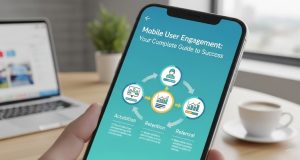Mobile Marketing Trends Shaping the Future of Digital Engagement

Mobile marketing has evolved from a supplementary channel to the cornerstone of digital strategy. With mobile devices accounting for over half of global web traffic, marketers can no longer treat mobile as an afterthought. The landscape shifts rapidly, driven by technological advances, changing consumer behaviors, and new platform capabilities.
Understanding these trends isn’t just about staying current—it’s about positioning your brand to connect with audiences where they spend most of their digital time. From artificial intelligence reshaping personalization to emerging technologies creating entirely new touchpoints, mobile marketing continues to redefine how businesses reach and engage customers.
This comprehensive guide explores the most significant mobile marketing trends transforming the industry and provides actionable insights for implementing these strategies effectively.
AI-Powered Personalization Takes Center Stage

Artificial intelligence has moved beyond buzzword status to become a practical tool for creating highly personalized mobile experiences. Machine learning algorithms now analyze user behavior patterns, preferences, and contextual data to deliver content that feels individually crafted.
Smart recommendation engines power everything from product suggestions to content curation. These systems learn from user interactions, purchase history, and browsing patterns to predict what customers want before they know it themselves. The result is higher engagement rates and improved conversion metrics.
Dynamic Content Optimization
AI-driven dynamic content changes in real-time based on user data. A retail app might show different product categories to users based on their location, time of day, or previous shopping behavior. This level of personalization creates more relevant experiences that drive engagement and sales.
Predictive analytics help marketers anticipate customer needs and deliver timely, relevant messages. By analyzing historical data and current behavior patterns, AI can identify the optimal time to send push notifications or display specific offers.
Video Content Dominates Mobile Screens
Video consumption on mobile devices continues its upward trajectory, with short-form content leading the charge. Platforms like TikTok and Instagram Reels have demonstrated the power of bite-sized video content, influencing how brands approach mobile marketing strategies.
Vertical video formats have become the standard for mobile-first content. This format maximizes screen real estate and creates immersive viewing experiences that capture attention more effectively than traditional horizontal videos.
Interactive Video Experiences
Interactive elements within videos are gaining traction as they boost engagement and provide valuable data insights. Features like clickable hotspots, polls, and swipe-up actions transform passive viewers into active participants.
Live streaming continues to grow as a powerful marketing tool, particularly for product launches, behind-the-scenes content, and real-time customer engagement. The immediacy and authenticity of live video create stronger connections between brands and audiences.
Voice Search Optimization Becomes Essential
Voice-activated searches are reshaping SEO strategies for mobile marketing. With the proliferation of smart speakers and voice assistants on mobile devices, optimizing for conversational queries has become crucial for maintaining visibility.
Voice searches tend to be longer and more conversational than text-based queries. Users might ask, “Where can I find the best pizza near me?” rather than typing “best pizza nearby.” This shift requires content strategies that address natural language patterns and question-based searches.
Local Voice Search Opportunities
Voice search presents significant opportunities for local businesses. Users frequently use voice commands for location-based queries, making local SEO optimization more important than ever. Businesses that optimize for “near me” searches and maintain accurate local listings can capture valuable voice search traffic.
Augmented Reality Enhances Shopping Experiences
Augmented reality has evolved from a novelty to a practical tool for mobile marketing, particularly in retail and e-commerce. AR technology allows customers to visualize products in their environment before making purchase decisions.
Virtual try-on experiences for clothing, cosmetics, and accessories reduce the uncertainty associated with online shopping. Customers can see how products look on them or in their homes, leading to higher confidence in purchase decisions and reduced return rates.
AR-Powered Product Demonstrations
Brands are using AR to create interactive product demonstrations that go beyond traditional video content. These experiences allow users to explore product features, understand functionality, and visualize benefits in ways that static images or videos cannot achieve.
Social Commerce Integration Accelerates

Social media platforms are becoming full-featured shopping destinations. Instagram Shopping, Facebook Marketplace, and TikTok Shopping have transformed social feeds into product catalogs, creating seamless paths from discovery to purchase.
The integration of shopping features directly within social platforms reduces friction in the customer journey. Users can discover, research, and purchase products without leaving their favorite social media apps.
Influencer-Driven Commerce
Influencer marketing has evolved to include direct commerce capabilities. Creator-led shopping experiences, where influencers can sell products directly through their content, are becoming more sophisticated and effective at driving sales.
Privacy-First Marketing Strategies
Growing privacy concerns and regulatory changes are reshaping mobile marketing approaches. Apple’s App Tracking Transparency and similar initiatives from other platforms have forced marketers to reconsider data collection and targeting strategies.
First-party data collection has become more valuable as third-party cookies phase out. Brands are investing in direct relationships with customers through loyalty programs, email subscriptions, and owned media channels.
Contextual Targeting Solutions
Contextual advertising, which targets based on content rather than user behavior, is experiencing a renaissance. This approach respects user privacy while still delivering relevant advertisements based on the content users are actively engaging with.
Progressive Web Apps Gain Momentum
Progressive Web Apps (PWAs) offer app-like experiences through web browsers, combining the best aspects of websites and native applications. These solutions provide fast loading times, offline functionality, and push notifications without requiring app store downloads.
PWAs eliminate many barriers to user engagement by removing the friction of app downloads and installations. Users can access full-featured experiences directly through their browsers while still receiving app-like functionality.
5G Technology Unlocks New Possibilities
The rollout of 5G networks is creating opportunities for richer, more interactive mobile experiences. Faster data speeds and lower latency enable high-quality video streaming, real-time gaming, and complex AR/VR applications on mobile devices.
Enhanced connectivity allows for more sophisticated marketing campaigns that were previously limited by bandwidth constraints. Marketers can deliver higher quality content and more interactive experiences without worrying about loading times or data usage concerns.
Hyper-Localization Strategies
Location-based marketing has evolved beyond simple geographic targeting to include hyper-local personalization. Brands are using precise location data, weather conditions, local events, and cultural factors to create highly relevant marketing messages.
Geofencing technology enables marketers to trigger specific campaigns when users enter defined geographical areas. Retailers can send special offers when customers approach their stores, while restaurants can promote lunch specials to nearby office workers.
The Road Ahead for Mobile Marketing
Mobile marketing continues to evolve rapidly, driven by technological innovation and changing consumer expectations. Success requires staying informed about emerging trends while maintaining focus on fundamental principles of user experience and value creation.
The brands that thrive will be those that balance innovation with practicality, embracing new technologies while ensuring they serve real customer needs. As mobile devices become even more central to daily life, the opportunities for meaningful engagement will only continue to grow.
Start by evaluating which trends align best with your audience and business objectives. Test new approaches on a small scale, measure results carefully, and scale successful strategies. The mobile marketing landscape rewards those who move quickly while maintaining strategic focus on long-term customer relationships.





